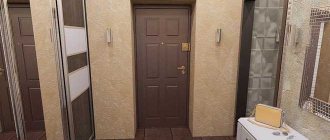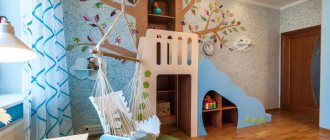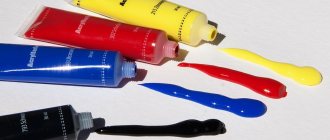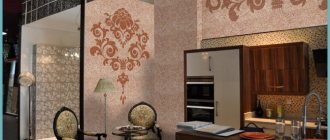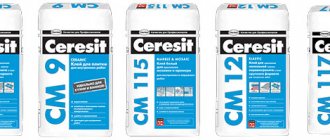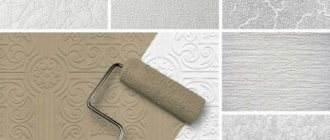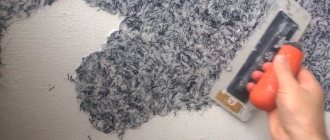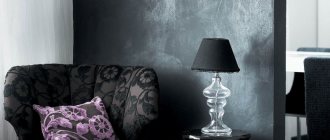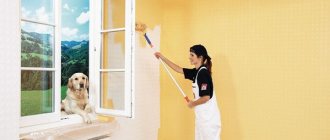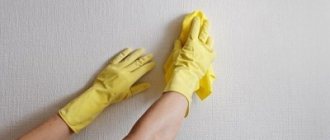The consumption of wallpaper glue per 1 m2 is usually indicated on the packaging of the purchased composition, but practice shows that this consumption is not always accurate and during work, as a rule, the glue runs out at the most inopportune moment.
It is also not uncommon for cases when, after completing wallpapering of the areas planned for renovation, a large amount of unclaimed adhesive remains, which has to be thrown away.
Types of wallpaper glue, their characteristics and properties
| Name | Weight | Type of wallpaper | Square | Water per pack (l) | Drying |
| AXTON | 180 g | Paper | 5 rolls | 5 | 48 hours |
| Name | Weight | Type of wallpaper | Square | Water per pack (l) | Drying |
| AXTON | 180 g | Vinyl | 5 rolls | 4 | 48 hours |
| Name | Weight | Type of wallpaper | Square | Water per pack (l) |
| KLEO ULTRA 25 | 250 g | Glass wallpaper | 18-25 m2 | 3,5 |
| Non-woven | 30-40 m2 | 5 | ||
| Vinyl | 30-40 m2 | 5 | ||
| Special wallpaper | 30-40 m2 | 5 | ||
| Padding | 55 m2 | 6,5 |
| Name | Weight | Type of wallpaper | Square | Water per pack (l) |
| KLEO SMART | 200 g | Vinyl | Light wallpaper - 7-9 rolls (35-45 m2) | 7,5 |
| Heavy wallpaper - 5-7 rolls (25-35 m2) | 6 |
| Name | Weight | Type of wallpaper | Square | Water per pack (l) |
| KLEO OPTIMA | 100 g | Paper | Paper 4-5 rolls (20-25 m2) | 3,5 |
| Duplex 3-4 (15-20 m2) | 3 |
| Name | Weight | Type of wallpaper | Square | Water per pack (l) |
| AXTON | 280 g | Non-woven | 6 rolls of wallpaper (30 m2) | 5 |
| Name | Weight | Type of wallpaper | Square | Water per pack (l) |
| KLEO ULTRA 50 | 500 g | Glass wallpaper | 35-50 m2 | 7,5 |
| Any heavy wallpaper | 60-80 m2 | 10 | ||
| Padding | 110 m2 | 13 |
| Name | Weight | Type of wallpaper | Square | Water per pack (l) |
| KLEO PHOTO 12 | 85 g | Photo wallpaper | Duplex 12-15 m2 | 2,5 |
| Non-woven 6-8 m2 | 4 |
| Name | Weight | Type of wallpaper | Square | Water per pack (l) | Drying |
| AXTON | 500 g | Glass wallpaper | 6 rolls (25 m2) | 4,5 | 48 hours |
| Name | Weight | Type of wallpaper | Square | Water per pack (l) | Drying |
| AXTON | 450 g | For all types of heavy wallpapers | 10 rolls (50 m2) | 7 | 48 hours |
Average consumption
With the advent of new types of wallpaper, adhesive compositions corresponding to them began to appear. Therefore, the modern building materials market has a huge variety of wallpaper glues. The differences between types depend on the type and condition of the surface, as well as the material being glued. The average glue consumption can be calculated for each type of wallpaper. There are these types:
- Glue for all types of paper wallpaper - available in 180g weight, suitable for paper varieties. The indicated amount when diluted with 5 liters of water is enough for 5 rolls.
2. Vinyl wallpaper adhesive is also sold in 180g packs, diluted with 4 liters of water, used for 4-5 rolls.
3. Ultra glue in a 250 g package is suitable for glass wallpaper (18-25 m²), vinyl, non-woven, special wallpaper (30-40 m²), as well as priming (55 m²).
4. Cleosmart is produced in packages of 200 grams, it is suitable for light vinyl wallpaper of 7-9 rolls, the area of the room is about 35 m², 7.5 liters of water are needed to prepare the glue, as well as heavy vinyl wallpaper - you can paste 5-7 rolls from 25 to 35 m², you will need 6 liters of water.
Paper wallpaper can be glued using simple wallpaper glue, which is based on starch or its alternative - methylcellulose. For other types of wallpaper, specialized glue is required, the consumption of which is determined in each case individually.
For fabric, non-woven and vinyl wallpapers, it is very important to choose those types of glue that contain up to 50% PVC and PVA emulsions. It can also be used for glass wallpaper. Specialized glue will be appropriate in cases where work is carried out in the cold season, in rooms with high levels of humidity, drafts and other difficult conditions.
Dependence of glue consumption on the materials used
The heavier the wallpaper, the more glue you will need.
To calculate the glue required for wallpapering a room, you must first of all decide on the type of wallpaper that will be used during work, select the glue and determine the area that needs to be covered with wallpaper. To do this, the following factors must be taken into account:
- It is necessary to carefully prepare the surface on which you plan to apply wallpaper.
- A wall covered with plaster must be thoroughly puttied and coated with a primer, since without these operations there will not be enough glue, since it will be absorbed into the porous base. The plaster consumption calculator will help you quickly calculate the required amount of material for a given type of construction work.
- It is necessary to take into account the type of wallpaper, since the glue consumption for them may be different. So, for example, for paper wallpaper, when working with which the glue is applied to the material itself, the consumption will be the same, but for wallpaper on a non-woven basis, when the glue is applied to the base to which the wallpaper is glued, the consumption will be completely different.
- When determining the area of the surface to be pasted, you must not forget to subtract from it the areas of window and door openings.
For each type of wallpaper you need to use a special glue
The ability to absorb glue from different materials and the unequal drying speed of the glue contribute to a wide variation in the consumption rates of the adhesive composition, the calculation of which is still advisable to make based on practical experience, and not on the descriptions on the packaging.
The most profitable option for wallpapering in terms of economical glue consumption is to work on a flat and smooth base.
Glue calculator
But to be honest, all the qualities stated in the commercials are actually true. Many wallpaper manufacturers recommend using adhesives from this particular company for the highest quality results.
Another famous brand is Quelyd
offers a very decent adhesive composition for non-woven wallpaper. It is perfectly applied to the wall surface, its consumption is small, and the anti-fungal additives in the composition are very effective.
When deciding what kind of wallpaper glue you need, remember several characteristics that high-quality brands are sure to have:
- all components are safe for human health;
- good glue can be prepared in ten minutes and is easy to work with;
- due to its high adhesive properties, such glue can be safely applied to any type of surface;
- High-quality glue will never leave stains, since it simply does not react with other materials.
Why calculate the amount of wallpaper glue in advance?
Typically, manufacturers indicate on the packaging all the necessary information, including consumption per 1 m2. But often only during the work it becomes clear that there is not enough adhesive or, conversely, too much. The reason is that manufacturers take into account “ideal” conditions and surface when calculating the rate. In reality, this is extremely unlikely to happen.
Preliminary calculations are needed to avoid wasting money on purchasing excess amounts of ready-made or dry mixture. Having calculated the required volume, you will buy as much glue as you need and save. If you plan to renovate several rooms, the savings will be significant.
There is another side to the coin - there may not be enough glue. If you use a ready-made mixture, then the inconvenience will be reduced to the need to go to the store again. When the paste is prepared on site, there is a risk that the quality of the new portion will be different from the one already used. Then the canvases may “lie” differently, they will lag behind the wall or wrinkle.
What's the best way to count?
Table of consumption of various types and wallpaper glue. Some popular brands are represented. Click to enlarge:
It must be said that the principle of counting itself is not so confusing. Therefore, if you are interested in how much glue is needed per 1 m2, you can write down brief instructions:
- To begin with, measure the length and height of the walls of the room, and then calculate the area that will need to be glued.
- In addition, do not forget to subtract the area occupied by doors, windows and other similar obstacles that you will not have to glue on top of.
- Consider whether you will need additional treatment of the wall surface and covering it with primer.
- After this, carefully study the instructions that are included on the glue packaging or indicated directly on it. As a rule, it indicates, in one form or another, consumption rates, based on their recalculation per 1 m2. On the other hand, sometimes it is indicated how many square meters of wallpaper your package will be enough for. In any case, based on these data, as well as knowing the area that will need to be glued, you can calculate how much wallpaper glue you may need.
Attention! In some cases, you will have to take into account the fact that among the surfaces to be pasted there is also a ceiling.
In any case, I would like to note that if you buy a little excess glue, this will be the right decision. On the other hand, it’s also not worth stocking up on a huge amount of powder, since it has a certain shelf life, after which you simply won’t need it.
If we talk about which wallpaper glue is the most economical, it should be noted that liquid formulations are optimal in this regard. On the other hand, such adhesives are quite expensive. Therefore, the increased price may offset all the benefits of low consumption, and you are unlikely to save money.
How to choose wallpaper glue
When choosing wallpaper glue, you must proceed from the information about the wallpaper itself, which is written on the label for it. The consumption of wallpaper glue per 1m2 is always written on the packaging (see photo). You can refer to our table.
In the production of wallpaper glue, there are several types of adhesives, these are:
- adhesive composition for paper-based wallpaper: light single-layer, duplex (embossed and smooth), corrugated, ceiling, washable; heavy wallpaper (coarse fiber), structural, foam wallpaper.
- Adhesive for non-woven and vinyl wallpaper. As part of the adhesive for vinyl and non-woven wallpaper, methylcellulose is added to the main components (starch and antifungal additives) (find out how long it takes non-woven wallpaper to dry);
- Universal adhesive designed for different types of wallpaper. The universal glue is based on modified starch and components that prevent the appearance of fungus.
- In addition to special-purpose adhesives, a universal adhesive is also produced. This glue can be used for wallpaper of any type. It contains esters of modified starch and antifungal substances.
Loading …
Glue for non-woven wallpaper
Non-woven wallpaper is popular due to its environmental friendliness and durability. To make you happy with the result of smooth and high-quality glued wallpaper, it is better to use special glue. As a rule, wallpaper manufacturers always indicate recommended adhesive compositions. What glue is needed for wallpaper based on non-woven fabric and what is its difference, we will look at below.
What is adhesive for non-woven wallpaper?
As a rule, any adhesive for non-woven fabric contains approximately the same components: starch with cellulose, special additives for better adhesion to the wall and to prevent the occurrence of fungus and mold (this point is important if the wallpaper is vinyl-coated).
Whatever good wallpaper glue you choose, the result of the work largely depends on the correct use of it. The fact is that this composition has some advantages and features, but the process of its use is also slightly different. It should be applied in a fairly generous layer, and in difficult places (this applies to corners, various ledges or ceilings), every centimeter of the wall surface should be especially thoroughly coated.
The best adhesive for non-woven wallpaper has a number of advantages over conventional universal ones.
- It is completely safe in an environmental sense. The adhesive for non-woven wallpaper contains no dangerous or harmful impurities, since all components are exclusively of natural origin. In addition, special ingredients are additionally added that prevent fungi from multiplying and prevent the formation of mold.
- This glue is very convenient to use even for the most inexperienced beginner. Before use, it is diluted with water and allowed to stand for about 20 minutes. After this, the adhesive mixture is completely ready for use.
- During the work, problems usually do not arise, since the composition of the glue allows you to quickly and easily fix a strip of wallpaper on the wall.
- If you wish, you can store the finished mixture for up to ten days, which can significantly save you money.
The best wallpaper glue
So, we have figured out the main characteristics of this type of glue, it’s time to look in more detail at which brand of glue to choose for non-woven wallpaper. Among the popular manufacturers, there are several with a fairly good reputation and excellent reviews.
These brands include KLEO
. Its advantages are the complete absence of lumps when mixing the dry mixture, an incredibly wide range for solving different issues when gluing walls. In addition, this mixture can be prepared in a few minutes, which significantly saves your time.
The well-known brand Metylan
needs no introduction.
Calculation of wallpaper adhesive consumption
Dilution of the glue is carried out strictly according to the instructions on the glue packaging
After studying the initial data on the technical characteristics and qualities of the materials used in the process of pasting and the walls themselves, you can proceed directly to the calculation itself. To do this, you must follow the following instructions:
- First, the area of the walls of the room is calculated. For example, the length of a room is 6 m, width 3 m and height 2.5 m. We calculate the area of the long wall 6 x 2.5 = 15 m2, then determine the area of the short wall 3 x 2.5 = 7.5 m2. We add the results obtained and multiply them by two: (15 + 7.5) x 2 = 45 m2. The area of doors and windows is subtracted from this value. For example, the window area is 1.2 x 1.5 = 1.8 m2 and the door area is 2.1 x 1.1 = 2.31 m2, 45-(1.8 + 2.31) = 40.89 m2. We get an area of approximately 41 m2;
- we determine the amount of wallpaper required for gluing on walls with a total area of 41 m2, with a wallpaper width, for example, equal to 0.53 m and a length equal to 10.5 m. 41/(0.53 x10.5) = 7.37 rolls ;
- Next, using the instructions on the packaging, we determine the volume of glue required to stick a given amount of wallpaper. For example, a package of glue weighing 200 grams is usually written that this is enough to stick 6-9 rolls;
- Accordingly, in the case under consideration, one package of glue will be enough to wallpaper a room.
When calculating how much glue is needed for non-woven and vinyl wallpaper, you need to take into account their actual width. When diluting the dry adhesive composition with water, you must follow the instructions indicated on the packaging. For more information on how to properly prepare wallpaper glue, watch this video:
Even an open pack of wallpaper adhesive cannot be stored for a long time, so it is necessary to make the most accurate calculations of the adhesive.
In any case, before purchasing glue, you should agree with the store about the possibility of returning unused adhesive composition after use.
Wallpaper glue consumption per 1m2: how much wallpaper composition is needed
But you shouldn’t trust these data completely, since they are, to put it mildly, somewhat overestimated.
Glue for light wallpaper.
The video in this article shows the principle of mixing glue.
Wallpaper adhesive consumption for vinyl wallpaper
For gluing light vinyl wallpaper, the same amount of glue is used as for heavy vinyl wallpaper. When using a primer, its consumption will be higher. On average, 5 rolls will require 150 grams of dry glue.
Regardless of the type of wallpaper, the preparation of glue remains the same and does not require the use of any special skills:
- Warm water is filled into the container;
- Dry glue from the packaging is gradually poured in. At the same time, the composition is continuously mixed;
- glue is added until the composition reaches medium viscosity;
- after preparing the composition, it settles for 5-7 minutes, after which it is mixed again;
- it's time to start gluing.
High-quality glue can remain open for no more than 2 hours at temperatures above +20 degrees Celsius. Good glue does not smell and does not emit any odors.
Wallpaper glue and its consumption
Wallpaper glue consumption
is a very interesting topic. The fact is that many (now almost all) manufacturers write on their packaging: “for 7 rolls,” “for 15 rolls,” or even “for 30 rolls.”
In fact, this is nothing more than a formal inscription that means almost nothing
, is a marketing ploy and is supported only by the fact that de jure it is not prohibited by the Consumer Rights Law. Therefore, under no circumstances and never should you be guided by this inscription when purchasing wallpaper glue.
What does the inscription indicate, for example, “for 7 rolls”? And she points out that in the presence of perfectly smooth walls with an ideal absorption coefficient, this package of glue is designed for sticking (on an ideally prepared surface) an amount of wallpaper 0.53 meters wide, identical to that contained in seven rolls of 10.05 meters.
“Ideal” values exist only in the tests to which the specified products are subjected before release into series. In real rooms and apartments everything is different. Therefore, the amount of wallpaper glue and its actual consumption differ significantly from what is written on the front of the package.
What then is this expense? Maybe there are some calculation formulas that could help us calculate the real amount of glue needed for the job?
I’ll say right away that there are no “magic” methods or formulas - everything is much simpler. Wallpaper glue, as you know, is not sold by weight, but is packaged in standard packs weighing 250 grams (there are also packs of other weights).
So, the calculation of the glue required for wallpapering walls is done as follows: on average, one pack is enough for 20 - 25 square meters of the surface of non-ideal (that is, the most ordinary) walls. The value changes upward due to the following factors:
a) putty walls (do not forget to make the necessary preparations before wallpapering, and be sure to prime the surfaces); b) very uneven walls (the more various differences there are on the surface, the more glue “gets stuck” in them, and therefore its consumption increases; c) pasting with light wallpaper (light wallpaper absorbs more glue than heavy wallpaper);
Based on this, for a room with an area of 12 - 15 square meters with ceilings 2.50 - 2.60 meters high, about 350 - 400 grams of dry glue, or approximately 1.5 packs, are required.
Correspondence of adhesive to the type of wallpaper and surface to be pasted
The more PVA emulsion in the wallpaper glue, the faster and better this glue will work. Heavy vinyl or fabric wallpaper, as well as areas of ceiling adhesive, are best glued with this glue, since a high level of adhesion is required. The same goes for the surface. For example, when gluing directly onto concrete, you need glue with a high PVA content.
In addition, if the walls and ceiling are made of plywood, fiberboard or boards, then you need glue with a high content of antiseptics, the quantity and composition of which must be indicated on the packaging. The same goes for rooms with high humidity.
How to avoid overspending
To avoid overuse of glue, it is necessary to accurately select the composition for the type of wallpaper to be pasted.
If this is glue for non-woven wallpaper, then it should be used on non-woven wallpaper. In the case of ordinary paper wallpaper, for example, the same adhesive may not work, which will result in overspending. To save ingredients, you can use the following tips and recommendations:
- When gluing non-woven wallpaper, it is necessary to smear the substance only on the canvas, and you should not cover the wall with glue.
- Sometimes rough, uneven surfaces can absorb a lot of glue, which also leads to overuse. Therefore, if the surface is not perfectly smooth, an additional priming procedure may be required.
- In some difficult places and areas, the wallpaper may not stick, especially if the surfaces are rough or capricious. In this case, in order to avoid excessive consumption of adhesive, it is necessary to make the paste of a thicker consistency. This will make the job easier and allow the wallpaper to fit perfectly the first time.
- To work with heavy, dense, expensive wallpaper with non-standard textures, it is best to choose ready-made liquid glue. This will help avoid overuse of other adhesives, which simply cannot cope with specific wallpaper. The composition will already be ready for use, it does not contain lumps, and lays down perfectly evenly. But such glue has a higher cost and a short shelf life.
- On average, if you decide to rely on the data indicated on the packaging, you need to calculate the optimal amount of adhesive, adding + 10% to the final result.
How to calculate quantity
To ensure that overuse of wallpaper glue does not become an unexpected surprise for you, make sure that the composition you purchase matches the type of wallpaper (paper, non-woven, vinyl, etc.). If you use the so-called “universal” or “for all types of wallpaper”, be prepared for the fact that the discrepancy between the tabular data (m2) on the packaging and the actual consumption can be up to 20%.
This is due to the fact that such adhesive solutions are prepared from the same composition, but using different amounts of water. The greater the dilution, the lighter the type you can glue.
Therefore, one pack can be enough for 5-7 strips (530 mm x 2500 mm) of heavy “foamed” vinyl, 7-10 of non-woven ones, or 15-20 strips of the same size of light single-layer paper.
Typically, the area occupied by windows and doors is neglected, since in standard houses they occupy 7-12% of the wall area. This error does not matter if you are renovating a small apartment or a separate room.
But, if the renovation area is 100 m2 or more, and the room has “French” windows, hanging equipment, stained glass windows, built-in furniture that cannot be dismantled during renovation, then their area, of course, should be subtracted from the surface area of the walls .
Wallpaper consumption per 1m2: instructions on how to calculate the rate, how much glue is needed, calculator, video and photo
Before starting repairs, every owner wants to know exactly the consumption of wallpaper per 1 m2. The now popular online wallpaper consumption calculator as a service is useful and useful for comparison, but it was invented for the lazy and rich.
Even the best programs will not provide accurate data if you plan to decorate a room of irregular shape. He won’t tell you whether you need to glue behind the furniture, what allowance to make on the niches, whether you need to take into account doors and windows, and finally, how much and what kind of glue you need to buy.
Assortment of wallpapers.
From here, the conclusion naturally suggests itself that it is much more economical to do everything yourself. In fact, the instructions by which the calculations are performed are elementary simple.
Of course, if you compare it with the speed of counting an online system, you will have to devote more time to this, by as much as 15 minutes. But such time costs are more than offset by cost savings, especially if the price of the material is serious.
Wallpaper gluing tool.
Which glue is more economical?
To ensure that glue consumption does not exceed the norm indicated on the packaging, experts recommend choosing liquid adhesive compositions. The quality of this glue is the highest, there are no lumps in it, but its cost is higher than others. Therefore, when trying to save money, it is very important not to exceed the estimate.
No specialist is able to make a 100% calculation of wallpaper adhesive, so any calculated figures will be approximate. The question is how closely will these calculations compare to the real numbers in reality?
I want to buy wallpaper glue!
I want to know more about glue!
What you need to know about preparation
As a rule, in most cases it is necessary to thoroughly prepare the surface before you proceed to wallpapering. One of the preparation stages before gluing is applying an additional layer of primer. Surely not everyone knows, but it is quite acceptable to use the same glue as a primer, which then, a little later, will be used when gluing wallpaper. The only difference is that its consistency is much more liquid compared to what will be used in the gluing process.
In any case, the consumption of wallpaper glue per 1 m2 in such cases will not increase much. When making calculations, it will be enough to add an additional 7-8 grams. glue solution.
We take into account the type of working surface
Yes, that’s true: the consumption of wallpaper glue is largely influenced by what kind of wall material you are going to glue on top. So, for wood and other materials derived from it, relatively little glue is required. At the same time, for harder materials, such as stone, hard plastic, concrete and the like, the average consumption of adhesives may increase. Therefore, this should also be kept in mind.
Why glue it tightly?
While many people think that tightly glued wallpaper is a very good result, this is not always true. After 5-7 years, any wallpaper needs to be replaced, so a really good result is when the wallpaper stays tight for the same 5-7 years, does not peel off or peel off, but can be easily removed during the next renovation.
It is important to know that the application technology and consumption of “Universal” brand wallpaper glue will differ depending on the wallpaper to which it is applied. All adhesives, regardless of components, are diluted with water in strict accordance with the instructions supplied with it and the number of rolls of wallpaper (see table). Read our article on how to hang wallpaper with your own hands.
How to use it correctly
When using, you must strictly follow the instructions.
Surface preparation
For gluing, you should only use a prepared wall that has no problems. To do this you need:
- clean the surface from dust and grease;
- remove old canvases, glue and bad plaster;
- apply new plaster to holes and uneven areas;
- pass with sandpaper, then moisten with water;
- After drying, the wall is ready to apply glue.
How to prepare the solution
All specific numbers can be found on the back of the package; the main stages of mixing are described below:
- pour the required amount of water into the container;
- pour dry glue into the container and continuously stir the composition with a drill;
- leave the mixture for 5-7 minutes;
- mix again and can be used.
Application
Now you can spread the cut pieces of wallpaper next to the place where they will be pasted. Apply a thin layer of glue to the canvas using a roller or soft bristles. All that remains is to carefully apply the wallpaper to the wall and hold it there for a while.
